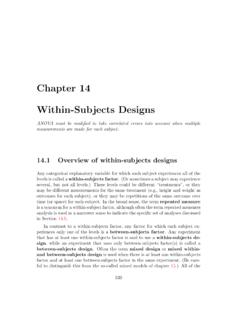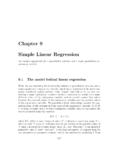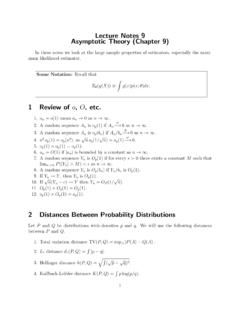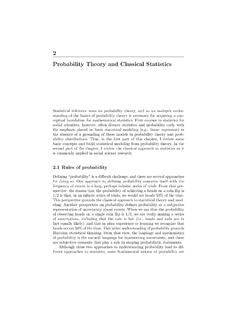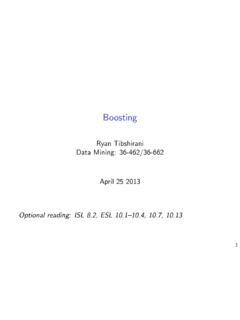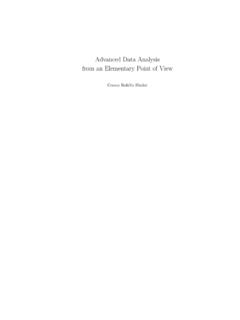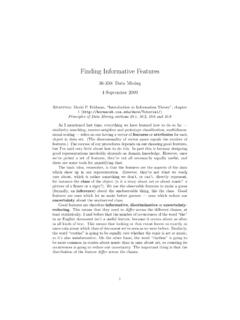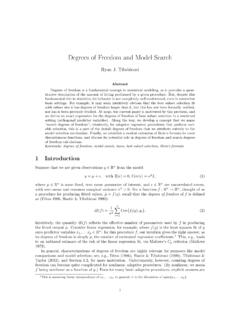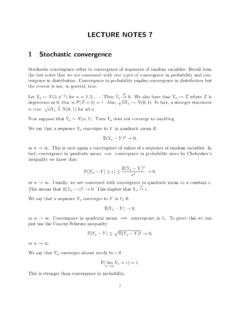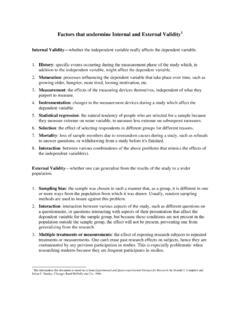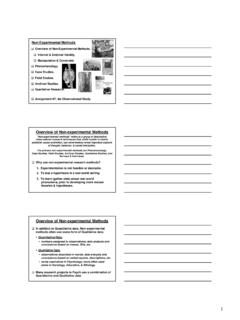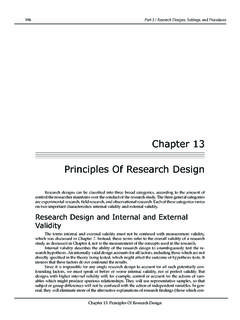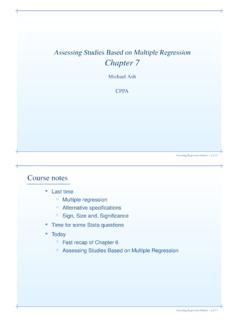Transcription of Chapter 8 Threats to Your Experiment - CMU Statistics
1 Chapter 8 Threats to your ExperimentPlanning to avoid of the main goals of this book is to encourage you to think from the pointof view of an experimenter, because other points of view, such as that of a readerof scientific articles or a consumer of scientific ideas, are easy to switch to after theexperimenter s point of view is understood, but the reverse is often not true. Inother words, to enhance the usability of what you learn, you should pretend thatyou are a researcher, even if that is not your ultimate a researcher, one of the key skills you should be developing is to try, inadvance, to think of all of the possible criticisms of your Experiment that may arisefrom the reviewer of an article you write or the reader of an article you Chapter discusses possible complaints about internal validity , external validity ,construct validity , Type 1 error, and are using Threats to mean things that will reduce the impact ofyour study results on science, particularly those things that we havesome control 8.
2 Threats TO your internal validityIn a well-constructed Experiment in its simplest form we manipulate variable Xand observe the effects on variable Y. For example, outcome Y could be numberof people who purchase a particular item in a store over a certain week, and internal VALIDITY193could be some characteristics of the display for that item, such as use of picturesof people of different status for an in-store advertisement ( , a celebrity vs. anunknown model). internal validityis the degree to which we can appropriatelyconclude that the changes in Xcausedthe changes in study of causality goes back thousands of years, but there has been a resur-gence of interest recently. For our purposes we can definecausalityas the state ofnature in which an active change in one variable directly changes the probabilitydistribution of another variable. It does not mean that a particular treatment isalwaysfollowed by a particular outcome, but rather that some probability ischanged, a higher outcome is more likely with a particular treatment com-pared to without.
3 A few ideas about causality are worth thinking about ,association, which is equivalent to non-zero correlation (see section )in statistical terms, means that we observe that when one variable changes, an-other one tends to change. We cannot have causation without association, but justfinding an association is not enought to justify a claim of does not necessarily imply variables X and Y ( , the number of televisions (X) in various countriesand the infant mortality rate (Y) of those countries) are found to be associated,then there are three basic possibilities. First X could be causing Y (televisionslead to more health awareness, which leads to better prenatal care) or Y could becausing X (high infant mortality leads to attraction of funds from richer countries,which leads to more televisions) or unknown factor Z could be causing both Xand Y (higher wealth in a country leads to more televisions and more prenatalcare clinics).
4 It is worth memorizing these three cases, because they should alwaysbe considered when association is found in an observational study as opposed toa randomized Experiment . (It is also possible that X and Y are related in morecomplicated ways including in large networks of variables with feedback loops.)Causation ( X causes Y ) can be logically claimed if X and Y are associated,and X precedes Y, and no plausible alternative explanations can be found, par-ticularly those of the form X just happens to vary along with some real cause ofchanges in Y (called confounding).Returning to the advertisement example, one stupid thing to do is to place all ofthe high status pictures in only the wealthiest neighborhoods or the largest stores,194 Chapter 8. Threats TO your Experiment while the low status pictures are only shown in impoverished neighborhoods orthose with smaller stores. In that case a higher average number of items purchasedfor the stores with high status ads may be either due to the effect of socio-economicstatus or store size or perceived status of the ad.
5 When more than one thing isdifferent on average between the groups to be compared, the problem is calledconfoundingand confounding is a fatal threat to internal that the definition of confounding mentions different on average . Thisis because it is practically impossible to have no differences between the subjectsin different groups (beyond the differences in treatment). So our realistic goal isto have no difference on average. For example if we are studying both males andfemales, we would like the gender ratio to be the same in each treatment the store example, we want the average pre-treatment total sales to be thesame in each treatment group. And we want the distance from competitors to bethe same, and the socio-economic status (SES) of the neighborhood, and the racialmakeup, and the age distribution of the neighborhood, etc., etc. Even worse, wewant all of the unmeasured variables, both those that we thought of and those wedidn t think of, to be similar in each treatment sine qua non of internal validity israndom assignment of treatmentto experimental units (different stores in our ad example).
6 Random treatmentassignment (also called randomization) is usually the best way to assure that allof the potential confounding variables are equal on average (also called balanced)among the treatment groups. Non-random assignment will usually lead to eitherconsciously or unconsciously unbalanced groups. If one or a few variables, suchas gender or SES, are known to be critical factors affecting outcome, a good al-ternative isblock randomization, in which randomization among treatments isperformed separately for each level of the critical (non-manipulated) explanatoryfactor. This helps to assure that the level of this explanatory factor is balanced(not confounded) across the levels of the treatment current practice randomization is normally done using computerized randomnumber generators. Ideally all subjects are identified before the Experiment beginsand assigned numbers from 1 to N (the total number of subjects), and then acomputer s random number generator is used to assign treatments to the subjectsvia these numbers.
7 For block randomization this can be done separately for eachblock. If all subjects cannot be identified before the Experiment begins, some waymust be devised to assure that each subject has an equal chance of getting eachtreatment (if equal assignment is desired). One way to do this is as follows. internal VALIDITY195there are k levels of treatment, then collect the subjects until k (or 2k or 3k,etc) are available, then use the computer to randomly assign treatments amongthe available subjects. It is also acceptable to have the computer individuallygenerate a random number from 1 to k for each subject, but it must be assuredthat the subject and/or researcher cannot re-run the process if they don t like can occur because we purposefully, but stupidly, design our exper-iment such that two or more things differ at once, or because we assign treatmentsnon-randomly, or because the randomization failed . As an example of designedconfounding, consider the treatments drug plus psychotherapy vs.
8 Placebo fortreating depression. If a difference is found, then we will not know whether thesuccess of the treatment is due to the drug, the psychotherapy or the no difference is found, then that may be due to the effect of drug cancelingout the effect of the psychotherapy. If the drug and the psychotherapy are knownto individually help patients with depression and we really do want to study thecombination, it would probably better to have a study with the three treatmentarms of drug, psychotherapy, and combination (with or without the placebo), sothat we could assess the specific important questions of whether drug adds a ben-efit to psychotherapy and vice versa. As another example, consider a test of theeffects of a mixed herbal supplement on memory. Again, a success tells us thatsomething in the mix helps memory, but a follow-up trial is needed to see if all ofthe components are necessary. And again we have the possibility that one compo-nent would cancel another out causing a no effect outcome when one componentreally is helpful.
9 But we must also consider that the mix itself is effective whilethe individual components are not, so this might be a good terms of non-random assignment of treatment, this should only be donewhen necessary, and it should be recognized that it strongly, often fatally, harmsthe internal validity of the Experiment . If you assign treatment in some pseudo-random way, alternating treatment levels, you or the subjects may purposelyor inadvertently introduce confounding factors into your , it must be stated that although randomization cannot perfectly balanceall possible explanatory factors, it is the best way to attempt this, particularlyfor unmeasured or unimagined factors that might affect the outcome. Althoughthere is always a small chance that important factors are out of balance afterrandom treatment assignment ( , failed randomization), the degree of imbalanceis generally small, and gets smaller as the sample size gets 8. Threats TO your EXPERIMENTIn experiments, as opposed to observational studies, the assignmentof levels of the explanatory variable to study units is under the controlof the fromobservational studiesin that in an Experiment atleast the main explanatory variables of interest are applied to the units of obser-vation (most commonly subjects)under the control of the experimenter.
10 Do notbe fooled into thinking that just because a lot of careful work has gone into astudy, it must therefore be an Experiment . In contrast to experiments, in obser-vational studies the subjects choose which treatment they receive. For example,if we perform magnetic resonance imaging (MRI) to study the effects of stringinstrument playing on the size of Broca s area of the brain, this is an observationalstudy because the natural proclivities of the subjects determine which treatment level (control or string player) each subject has. The experimenter did not controlthis variable. The main advantage of an Experiment is that the experimenter canrandomly assign treatment, thus removing nearly all of the confounding. In theabsence of confounding, a statistically significant change in the outcome providesgood evidence for a causal effect of the explanatory variable(s) on the people consider internal validity to be not applicable to observational stud-ies, but I think that in light of the availability of techniques to adjust for someconfounding factors in observational studies, it is reasonable to discuss the internalvalidity of observational validity is the ability to make causal conclusions.
